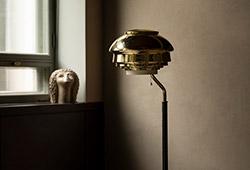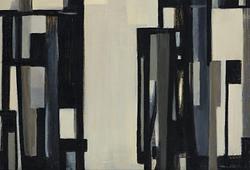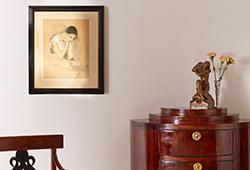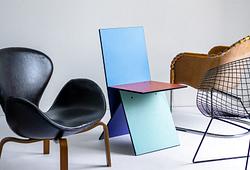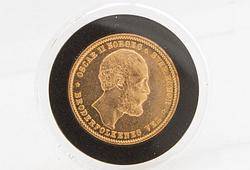Alexander Calder
Untitled
Executed ca 1949. Standing mobile. Sheet metal, brass, led, wire and paint. 14 x 34.5 x 10 cm (5.5 x 13.5 x 4 in). This work is registered in the archives of the Calder Foundation, New York, under application number A15332.
Provenance
Curt Valentin/Buchholz Gallery, New York.
Swedish private collection, acquired from the above in 1949.
Thence by descent to present owner.
Exhibitions
Buchholz Gallery, New York, "Alexander Calder", 30 November - 17 December 1949.
More information
“When everything goes right a mobile is a piece of poetry that dances with the joy of life and surprise.” E. Hutton and O. Wick (eds.), Calder, London 2004, p. 261.
The insect-like sculpture in this auction sweeps the room in wide movements with its long antennae. The mobile is able to move 360 degrees horizontally and also vertically. Each part moves independently from the other and plays an equally important role in the intricate mechanism.
Alexander Calder was the originator of movable sculptures, or ‘mobiles’ as his friend Marcel Duchamp christened them. He wanted to reawaken three-dimensional artworks and liberate them from their static form, even allowing them to move in space. His first mobile (1931) was powered by motors, but soon thereafter, still at the beginning of the 1930s, he found a way of utilising air currents in order to get the sculptures to move without the use of motors. Perfectly balanced, sensitive to the tiniest gust of air, the sculptures seemed to float independently in the air attached either to the ceiling or supported by static abstract iron sculptures that Calder called ‘stabiles’. An exhalation or a gentle touch with one’s finger was sometimes enough to get them to perform their airborne tricks. Set in motion they changed configurations and cast interesting shadows. Some of the larger mobiles were even able to ‘sing’, as they rubbed against each other like frozen leaves in the wind.
Calder, who was a trained engineer, belonged to the Parisian avant-garde of the 1920s and 30s, where Surrealism and Dadaism, as well as abstract art were in focus. Inspired by Piet Mondrian he kept to primary colours – red, blue and yellow.
He also shared his playfulness and his use of primary colours with his friend Miró. One of his most important works, Cirque Calder, which he would present to his Paris friends as a two-hour long performance, is today permanently on display at the Whitney Museum of American Art in New York. In it models of animals and acrobats in wire, metal and fabric take to the circus stage. Calder would always have a bit of wire in his pocket to try out new ideas.
The 1940s turned out to be a significant period for Calder’s artistic practice. In 1943 MoMA arranged a retrospective of his work, which became a huge public success and was of paramount importance to Calder’s subsequent career. In 1946 Duchamp organised an exhibition of predominantly Calder’s hanging and standing mobiles at Galerie Louis Carré in Paris. The preface to the catalogue was written by Jean-Paul Sartre.
In the 1950s Calder began producing his monumental sculptures, which today stand outside several important museums. For example, the thirteen metre tall motor-powered mobile The Four Elements can be found outside Moderna Museet in Stockholm or Janey Waney in the sculpture park of the Danish art museum Louisiana. His tallest sculpture, El Sol Rojo, a 20.5 metres tall stabile, was created for the 1968 Olympic Summer Games in Mexico City.
The artwork in the auction, Untitled, was acquired at Galerie Buchholz in New York in 1949 at the exhibition Alexander Calder. In the 1930s Curt Valentin had worked as an art dealer for Galerie Buchholz in Berlin. In 1937 he emigrated to the USA with enough artworks by German modernists that he could open a gallery of the same name in New York. Valentin curated many important exhibitions and many of the most well-known artists were represented by his gallery. His love for sculpture was demonstrated in the artists and the shows that he put on.
Artist
Alexander Calder was an American Sculptor and artist born in Philadelphia. He initially studied mechanical engineering at Stevens Institute of Technology in Hoboken, but later changed to study at the Art Students League in New York and at Académie de la Grande Chaumière in Paris. When Calder visited Piet Mondrian’s studio in Paris, the artist felt immense inspiration, facilitating the creation of his abstract art and his joining of the group "Abstraction-Création". He is well known for his Chinese sculptures, and artworks Marcel Duchamp dubbed as “mobiles”. As well as sculptures, Calder also illustratedbooks and magazines at the same time as he also made jewellery. Calder explored the dynamics of movement in his art, diverging from the traditional notion of artworks as static objects.
Read more




